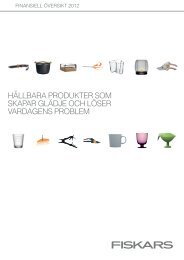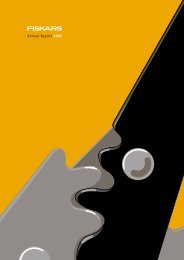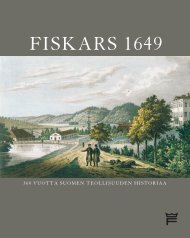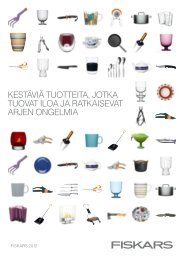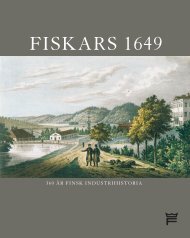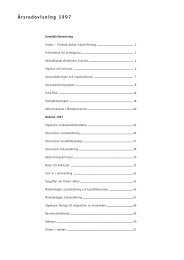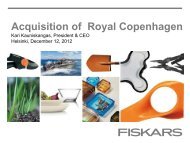FISKARS 1649 â 360 years of Finnish industrial history
FISKARS 1649 â 360 years of Finnish industrial history
FISKARS 1649 â 360 years of Finnish industrial history
You also want an ePaper? Increase the reach of your titles
YUMPU automatically turns print PDFs into web optimized ePapers that Google loves.
Fiskars <strong>1649</strong><br />
Fiskars <strong>1649</strong><br />
Preparing kindling and fire<br />
wood at the rock face, stages<br />
in an early method <strong>of</strong> ore<br />
extraction.<br />
The Fiskars ironworks used mainly ore from<br />
the Utö mines in the outer Stockholm archipelago.<br />
Utö was one <strong>of</strong> Sweden’s oldest iron ore mines and<br />
is mentioned in King Gustavus Vasa’s land register<br />
<strong>of</strong> 1559. Finns, Södermanlanders and Norrlanders<br />
had the right to extract ore from the Utö mines.<br />
The particular mine used by the Finns was called<br />
Finngruva (Finns’ mine). From Utö, the ore was<br />
transported to Fiskars on ships or lighters owned<br />
or rented by the ironworks, first to the port <strong>of</strong><br />
Pohjankuru and from there, on smaller barges,<br />
along the Fiskars River to the ironworks.<br />
Making iron from ore in blast furnaces<br />
Along the Fiskars River, there were three rapids.<br />
The heavy crusher hammers on the eastern bank <strong>of</strong><br />
the lower rapids were powered by a water-wheel.<br />
The chunks <strong>of</strong> ore were first crushed here, although<br />
in Fiskars the ore was sometimes crushed by hand<br />
since the hammers could not be used during the<br />
dry season.<br />
The crushed ore was then taken to the Fiskars<br />
blast furnace, built on the western bank <strong>of</strong> the<br />
lower rapids. Before loading into the furnace, it<br />
was roasted and ground. It was then lifted onto the<br />
furnace ‘ring’, where the charging took place.<br />
In addition to iron ore, limestone and charcoal<br />
were also needed for the blast furnace. The charcoal<br />
was produced in kilns. The wood for burning was<br />
first stacked in large conical heaps and covered<br />
with earth. Once the kiln was fired, a slow burning<br />
The charcoal used in the blast furnaces was made by burning wood in kilns. The picture shows different stages <strong>of</strong> this work in<br />
the 18th century.<br />
12<br />
13




